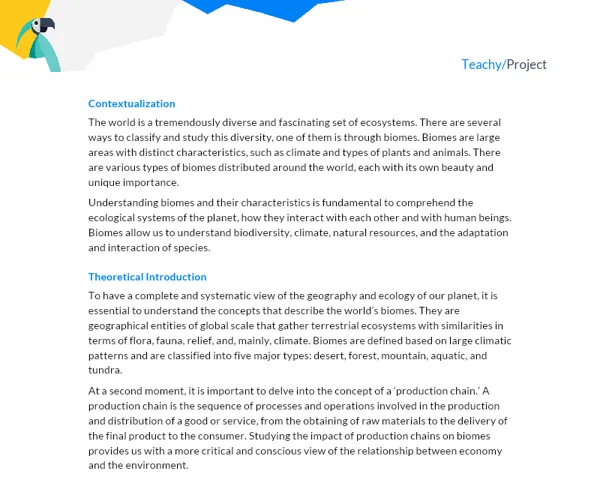Contextualization
The study of relief is one of the fundamental components in the field of physical geography and plays a crucial role in understanding the characteristics of the terrestrial environment. Relief is the shape of the Earth's surface, resulting from a complex series of geological and climatic processes such as weathering and the accumulation of material over time. The Earth's relief presents a variety of forms ranging from extensive plains to high and steep mountains, and each of these forms has certain characteristics that influence the climate, vegetation, and even human occupation.
Within geography, the study of landforms is a major field of study, as understanding landforms is vital to a variety of human activities. For example, engineers need to understand the characteristics of relief to build roads and buildings, while farmers use this information to grow food efficiently. Therefore, the study of relief is not only relevant to geographers, but to a wide range of professions.
The importance of studying relief, however, goes beyond practical applications in different professions. The Earth's relief has a direct influence on biodiversity, water resources, agriculture, economic activities and human occupation. Human modifications to the relief can have significant environmental and socioeconomic impacts. Therefore, understanding relief and how it is modified is vital for making decisions that seek sustainability.
The study of relief can be carried out through direct observation of the terrain and through topographic maps and aerial photographs. The analysis and interpretation of topographic maps and satellite images is a fundamental skill in geography. In addition, today we also have Geographic Information Systems (GIS), which are computational tools that allow the analysis and visualization of geographic data in various ways, including relief.
Supporting materials:
Practical Activity - "Exploring the Brazilian Relief"
Project objective
The main objectives of this project are:
- Understand the main types of relief and their characteristics.
- Analyze the distribution of different types of relief in Brazil.
- Identify the relationship between the types of relief and their consequences for climate, vegetation and human occupation.
Detailed description of the project
The work will be carried out in groups of 3 to 5 students and each group will have to choose a region of Brazil (North, Northeast, Midwest, Southeast or South) to study its relief. Based on this choice, students should research the main types of relief in the chosen region, analyze how these forms interfere with human occupation, the economy and the biodiversity of the region.
Required materials
To carry out this project, the groups will need:
- Internet access for research.
- Topographic maps of the chosen region. These maps can be found in geography books or online.
- Geographic Information System (GIS) software for visualizing geographic data.
Detailed step-by-step to carry out the activity
- Forming the groups and choosing the region to be studied.
- Research the main types of relief in the chosen region.
- Analyze the influence of these landforms on human occupation, the economy and the biodiversity of the region.
- Use topographic maps and GIS software to visualize and interpret the distribution of landforms.
- Prepare an oral and written presentation of the results. The presentation should include images, maps and graphics to illustrate your findings.
- Review and prepare the final project report.
Project delivery
At the end of this project, students will submit a report containing:
- Introduction: Contextualization of the theme, presenting the chosen geographic region and the relevance of the relief study for that region.
- Development: A detailed explanation of the types of relief found in the region, as well as their impact on human occupation, flora and fauna, and the economy. It should also include the methodology used for the research and analysis.
- Conclusions: Summary of the main points of the report, discussion of the results found and how they relate to the central theme of the project, as well as the reflections and learning acquired by carrying out the project.
- Bibliography: References of all sources that were used in the project, including books, websites, videos, among others.
It is expected that, at the end of the project, students will have acquired a deeper understanding of the different types of relief, their characteristics and their implications. In addition, with the writing of the report, they will also be developing important skills such as research, teamwork, and written and oral communication.

